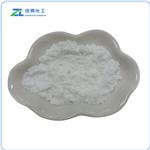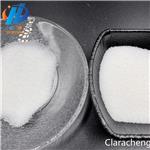- Chlorobutanol
-

- $6.00 / 1kg
-
2024-05-23
- CAS:57-15-8
- Min. Order: 1kg
- Purity: More than 99%
- Supply Ability: 2000KG/Month
- Chlorobutanol
-

- $40.00/ kg
-
2024-05-08
- CAS:57-15-8
- Min. Order: 1kg
- Purity: 99%
- Supply Ability: 5000kg/Week
- Chlorobutanol
-

- $20.00 / 25kg
-
2024-04-27
- CAS:57-15-8
- Min. Order: 1kg
- Purity: 99.9%
- Supply Ability: 200000kg
|
| | Chlorobutanol Basic information |
| Product Name: | Chlorobutanol | | Synonyms: | 2-TRICHLOROMETHYL-2-PROPANOL;2-METHYL-1,1,1-TRICHLORO-2-PROPANOL;BETA,BETA,BETA-TRICHLORO-TERT-BUTYL ALCOHOL;ACETONE CHLOROFORM;2-Trichhloromethyl-2-propanol;Acetone chloroform~Chloretone~Chlorobutanol~1-Methyl-1-(trichloromethyl)ethanol~1,1,1-Trichloro-2-methyl-2-propanol;ACETONE CHLOROFORM HEMIHYDRATE DAB, PH. EUR., B.P., N. F., PH. FRANC.;CHLORBUTOLANHYDROUS | | CAS: | 57-15-8 | | MF: | C4H7Cl3O | | MW: | 177.46 | | EINECS: | 200-317-6 | | Product Categories: | CHLORETONE;Organics | | Mol File: | 57-15-8.mol |  |
| | Chlorobutanol Chemical Properties |
| Melting point | ~78 °C | | Boiling point | 173 °C | | density | 1.3170 (estimate) | | Fp | >110°C | | storage temp. | Sealed in dry,Room Temperature | | solubility | Slightly soluble in water, very soluble in ethanol (96 per cent), soluble in glycerol (85 per cent). | | form | Solid | | pka | 12.87±0.29(Predicted) | | color | Hydrated crystals | | Odor | camphor odor | | Water Solubility | 8g/L(20 ºC) | | Stability: | Stable. Generates toxic fumes on combustion. | | LogP | 2.030 | | CAS DataBase Reference | 57-15-8(CAS DataBase Reference) | | NIST Chemistry Reference | 2-(Trichloromethyl)-2-propanol(57-15-8) | | EPA Substance Registry System | 1,1,1-Trichloro-2-methyl-2-propanol (57-15-8) |
| | Chlorobutanol Usage And Synthesis |
| Chemical Properties | Volatile, colorless or white crystals with a musty, camphoraceous
odor. | | Chemical Properties | White or almost white, crystalline powder or colourless crystals, sublimes readily | | Originator | Chlorobutanol,Narchem | | Uses | Plasticizer for cellulose esters and ethers,
preservative for biological fluids and solutions,
antimicrobial agent, anesthetic in dentistry. | | Uses | Chlorobutanol is used as a preservative and sedative. It has also been shown to exhibit antibacterial properties. | | Definition | ChEBI: Chlorobutanol is a tertiary alcohol. | | Production Methods | Chlorobutanol is prepared by condensing acetone and chloroform
in the presence of solid potassium hydroxide. | | Manufacturing Process | 33 g (0.59 mol) of powdered potassium hydroxide was added in small
amounts to a solution of 50 g (0.86 mol) of acetone in 100 g (0.84 mol) of
chloroform to form a reaction mixture containing approximately 0.7 mol of
KOH per mol of chloroform. The mixture was chilled to a temperature below
0°C, thoroughly agitated, and than allowed to stand at temperature of about
0°C for 24 hours. The mixture was then filtered and the filtrate was distilled.
The fraction boiling within the range of 165-175°C was poured into an equal
amount of water to precipitate the 1,1,1-trichloro-tert-butyl alcohol. The
precipitated 1,1,1-trichloro-tert-butyl alcohol was filtered and recrystallized
from an ethanol-water mixture and air dried. The yield of 1,1,1-trichloro-tert�butyl alcohol was 6 g, that is, somewhat less than 4% of the theoretical yield
based on chloroform charged. When calculated on the basis of chloroform
consumed the yield was about 15%. | | Therapeutic Function | Hypnotic, Anesthetic, Antiseptic, Pharmaceutic aid,
Ophthalmologic | | Synthesis Reference(s) | Journal of the American Chemical Society, 70, p. 1189, 1948 DOI: 10.1021/ja01183a092 | | Hazard | Action similar to chloral hydrate. Combustible. | | Pharmaceutical Applications | Chlorobutanol is primarily used in ophthalmic or parenteral dosage
forms as an antimicrobial preservative at concentrations up to 0.5%
w/v. It is commonly used as an antibacterial agent for
epinephrine solutions, posterior pituitary extract solutions, and
ophthalmic preparations intended for the treatment of miosis. It is
especially useful as an antibacterial agent in nonaqueous formulations.
Chlorobutanol is also used as a preservative in cosmetics ; as a plasticizer for cellulose esters and ethers; and has
been used therapeutically as a mild sedative and local analgesic in
dentistry. | | Safety Profile | Poison by ingestion. A narcotic. A skin and eye irritant. Mutation data reported. See also CHLORAL HYDRATE, whch acts similarly. Dangerous; can react with oxidizing materials. Combustible when exposed to heat or flame. When heated to decomposition it emits toxic fumes of Cl-. See also PHOSGENE. | | Safety | Chlorobutanol is widely used as a preservative in a number of
pharmaceutical formulations, particularly ophthalmic preparations.
Although animal studies have suggested that chlorobutanol
may be harmful to the eye, in practice the widespread use of
chlorobutanol as a preservative in ophthalmic preparations has
been associated with few reports of adverse reactions. A study of the
irritation potential of a local anesthetic on the murine cornea
indicated significant corneal surface damage in the presence of
0.5% w/v chlorobutanol, which may be related to the preservative’s
effective concentration. Reported adverse reactions to chlorobutanol
include: cardiovascular effects following intravenous
administration of heparin sodium injection preserved with chlorobutanol; neurological effects following administration of a
large dose of morphine infusion preserved with chlorobutanol;
and hypersensitivity reactions, although these are regarded as
rare.
The lethal human dose of chlorobutanol is estimated to be
50–500 mg/kg.
LD50 (dog, oral): 0.24 g/kg
LD50 (mouse, oral): 0.99 g/kg
LD50 (rabbit, oral): 0.21 g/kg | | storage | Chlorobutanol is volatile and readily sublimes. In aqueous solution,
degradation to carbon monoxide, acetone and chloride ion is
catalyzed by hydroxide ions. Stability is good at pH 3 but becomes
progressively worse with increasing pH. The half-life at pH 7.5
for a chlorobutanol solution stored at 258℃ was determined to be
approximately 3 months. In a 0.5% w/v aqueous chlorobutanol
solution at room temperature, chlorobutanol is almost saturated
and may crystallize out of solution if the temperature is reduced.
Losses of chlorobutanol also occur owing to its volatility, with
appreciable amounts being lost during autoclaving; at pH 5 about
30% of chlorobutanol is lost. Porous containers result in losses
from solutions, and polyethylene containers result in rapid loss.
Losses of chlorobutanol during autoclaving in polyethylene
containers may be reduced by pre-autoclaving the containers in a
solution of chlorobutanol; the containers should then be used
immediately. There is also appreciable loss of chlorobutanol
through stoppers in parenteral vials.
The bulk material should be stored in an airtight container at a
temperature of 8–158℃. | | Incompatibilities | Owing to problems associated with sorption, chlorobutanol is incompatible with plastic vials, rubber stoppers, bentonite, magnesium trisilicate, polyethylene, and polyhydroxyethylmethacrylate, which has been used in soft contact lenses. To a lesser extent, carboxymethylcellulose and polysorbate 80 reduce antimicrobial activity by sorption or complex formation. | | Regulatory Status | Included in the FDA Inactive Ingredients Database (IM, IV, and SC
injection; inhalations; nasal, otic, ophthalmic, and topical preparations).
Labeling must state ‘contains chlorobutanol up to 0.5%.’
Included in nonparenteral and parenteral medicines licensed in the
UK. Included in the Canadian List of Acceptable Non-medicinal
Ingredients.
In the UK, the maximum concentration of chlorobutanol
permitted for use in cosmetics, other than foams, is 0.5%. It is
not suitable for use in aerosols. |
| | Chlorobutanol Preparation Products And Raw materials |
|